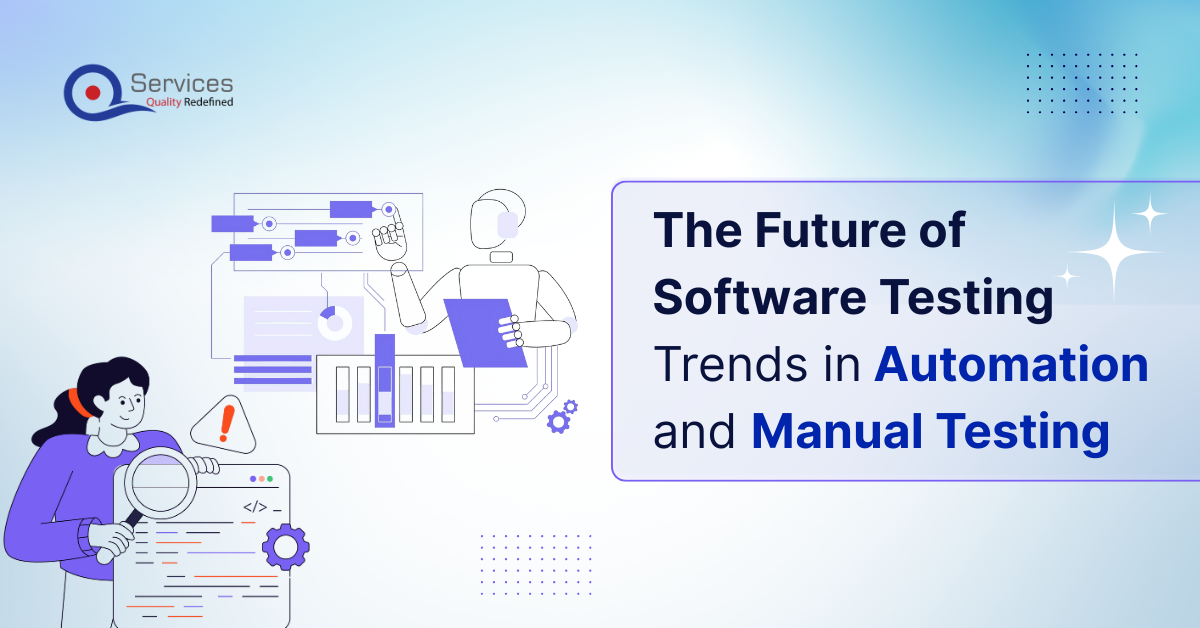
Home » The Role of Exploratory Testing in an Automated World

In the current era of software development, automated testing has emerged as a pillar of ensuring efficiency, speed, and consistency. Nevertheless, with the continued rise of automation, exploratory testing has not lost its place. Exploratory testing, fueled by human creativity and intuition, augments automated testing by revealing faults that scripts fail to identify. This blog discusses the significance of exploratory testing in an automated era, its advantages, techniques, and how it improves the overall testing process.
Exploratory testing is a hands-on, free-form technique where testers dynamically explore the application, creating and running tests on the fly. Contrary to automated testing, where tests are scripted ahead of time, exploratory testing depends on the tester’s creativity, experience, and instincts to discover defects and usability problems that are not anticipated.
This technique is especially suited to Agile cultures, where the requirements change rapidly, and testers must be very quick to keep up. It’s also an excellent tool to find edge cases, usability bugs, and cases that automated testing could miss.
These days, with the software development industry being more automated than ever, automated testing has become the backbone of delivering efficiency, consistency, and velocity. It is best suited for dealing with repetitive tests, regression testing, and performance testing, allowing teams to quickly pinpoint problems in clearly defined scenarios. Nevertheless, automated testing has limitations inherent to it. Automated tests are no better than the scripts they run, and they do not possess the human capability to think critically, learn from new situations, or venture into unexplored regions of an application. That is where exploratory testing comes into play.
Exploratory testing is a fluid, human-driven technique that depends on the tester’s intuition, imagination, and experience. In contrast to automated testing, which is based on scripted instructions, exploratory testing invites testers to engage with the application in real-time, mimicking actual user actions and revealing problems that automated tests may not catch. Here’s why exploratory testing is still important in an automated age:
Automated tests are programmed to check for anticipated results, but they tend not to catch subtle flaws like usability issues, inconsistent user experiences, or unforeseen behaviors. Exploratory testing uses human intuition to find these subtle defects, providing a better-quality user experience.
In Agile and DevOps environments, requirements and features evolve rapidly. Exploratory testing thrives in such dynamic settings, as it allows testers to adapt quickly to changes without the need for extensive script updates. This flexibility makes it an ideal complement to fast-paced development cycles.
Automated tests are generally written to test expected scenarios, but they might not catch edge cases or unexpected interactions. Exploratory testing gives testers the ability to explore the application at will, revealing hidden defects and scenarios that were not accounted for when test scripts were written.
As much as automated testing offers speed and repeatability, it is not capable of 100% test coverage. Exploratory testing is used to complete the gaps where automation is missing, providing a more complete review of the application. These methodologies combined provide an effective testing plan that offers balance between speed and completeness.
Get free Consultation and let us know your project idea to turn into an amazing digital product.

During the age of automation, where regression and repetitive testing is primarily done by machines, exploratory testing becomes an essential practice to counter the shortcomings of automated testing. Automation can perform well in running test cases with high precision and speed, but lacks in places where human judgment, creativity, and flexibility are needed. Exploratory testing, with its dynamic and free-style methodology, supplements automated testing by detecting problems that cannot be anticipated by scripts. These are the main advantages of exploratory testing in automated environments:
Automated testing is programmed to confirm certain, predefined situations, and this might leave some areas uncovered. Exploratory testing permits testers to step outside pre-scripted sequences and discover novel usage scenarios, boundary cases, and emergent behavior. This helps to give a more complete review of the application, limiting the possibility of unseen defects.
Exploratory testing gives instant feedback on the behavior of the application, allowing teams to detect and solve problems in real-time. It is especially beneficial in Agile and DevOps cultures, where quick iteration and continuous delivery are paramount. Catching errors early saves the cost and effort of fixing defects downstream in the development process.
Automated tests cannot test the user experience or reveal design flaws. Exploratory testing utilizes human testers to test the application from the user’s point of view, exposing usability problems, inconsistent user flows, and accessibility problems. It ensures that the application not only works right but also provides a smooth and intuitive experience for the user.
With constantly changing requirements in dynamic projects, it takes time and money to update and maintain automated test scripts. Exploratory testing, being a flexible and adaptive technique, is more suitable in such an environment. It enables testers to rapidly change their style without needing massive script updates, thus making it a cost-effective option for dynamic and changing projects.
Exploratory testing does not substitute automated testing but strengthens it. While automation addresses repetitive and bulk-oriented tasks, exploratory testing takes care of those that are human-oriented, for example large, complicated workflows, realistic user interaction, and innovative problem-solving. They complement each other to form a balanced test plan that extracts optimal efficiency and coverage.
In a world where more and more is being driven by automated testing, exploratory testing is still an essential practice for finding defects that scripts can’t predict. Automation is good at repetitive work and regression testing but doesn’t have the human instinct and flexibility to venture into new territory in an application. To get the most out of exploratory testing in an automated setup, testers can use a number of techniques specific to complementing automated systems. These methods not only increase test coverage but also confirm that application is tested from the technical and user perspective. Following are the most important exploratory testing methods for automated systems:
This method entails breaking testing activities into targeted, time-boxed sessions, each with a particular aim or objective. For instance, a session could be dedicated to investigating a new feature, testing a particular module, or confirming fixes for previously identified defects. By organizing exploratory testing into sessions, teams can stay on track, monitor progress, and guarantee that all key areas of the application are addressed.
Chartered exploration delivers a distinct mission or purpose to each testing session, which targets testers towards distinct areas of inquiry. An example of a charter would be “Investigate usability problems with the checkout process” or “See how the application behaves under conditions of poor networks.” Chartered exploration maintains that exploratory testing is still deliberate and directed in terms of what it addresses toward, while making room for intuitive and dynamic exploring.
Pair testing is centered on collaboration, with two testers (or a developer and a tester) working in tandem to navigate the application. This method promotes brainstorming, sharing of knowledge, and multiple viewpoints, resulting in the identification of defects that may otherwise be overlooked. Pair testing is best suited for complicated situations or technical areas that demand extensive technical knowledge.
Heuristic testing uses rules of thumb or experience-based rules to guide test effort. Testers can apply heuristics to detect high-risk areas, prioritize commonly used functionality, or test sections of the application that are most likely to contain defects. For instance, a heuristic can be “Test inputs at their boundaries” or “Investigate features that have recently changed.” This technique assists testers in making effective decisions regarding where to exert effort.
Error guessing makes use of the tester’s expertise and intuition in an attempt to anticipate where errors will be located. Through leveraging experience with a similar application or system in the past, the tester can analyze areas of likely weak points and focus testing in those areas. This method comes in handy to reveal edge cases or situations which may not have been tested automatically.
Although formal techniques are useful, freestyle exploration enables testers to engage with the application without preconceived limitations. Freestyle exploration is an open-ended technique that fosters creativity and can result in the identification of unforeseen problems or creative use cases. Freestyle exploration is commonly applied in the initial stages of testing to acquire a general overview of the application.
With this method, realistic scenarios or user stories are created to govern testing. To illustrate, one may create a scenario where the user makes a purchase, proceeds through several screens, or comes across an error. Through real-scenario application testing, users can test an application based on the way in which it reacts when realistic conditions are applied. Issues affecting overall experience can thus be identified through testing the application within realistic contexts.
Although exploratory testing has several advantages, it has its limitations:
1. Unsimplified Documentation:Owing to exploratory testing’s lack of scripts, findings require more time for documentation.
2. Test Skill Reliance: Whether or not exploratory testing proves useful relies extensively on the experience and skillset of the tester.
3. Difficulty Replicating Flaws: Problems uncovered by exploratory testing tend to be more difficult to reproduce than automated testing flaws.
4. Lack of Scheduling Time: Where Agile is emphasized, locating adequate time to devote to exploratory testing becomes increasingly difficult.
In order to reap the maximum benefit from exploratory as well as automated testing, here are some best practices that should be adopted:
1. Establish Defined Roles:Assign automated testing to do repetitive, high-volume testing and exploratory testing to accomplish innovative, high-value testing.
2. Cooperate Between Teams: Cooperate between manual testers and automation testers to learn from each other and enhance test coverage.
3. Take Advantage of Tools: Utilize exploratory testing tools such as Session Tester, TestRail, or Rapid Reporter to document and keep track of observations.
4. Implement Feedback Loops: Apply learnings from exploratory testing to refine automated test scripts and vice versa.
5. Target High-Risk Zones: Target exploratory testing resources at zones where automated tests could be inadequate, for example, usability or sophisticated workflows.
Some tools can supplement exploratory testing in automated contexts:
Helps manage and document exploratory testing sessions.
Tracks exploratory testing results and integrates with automated testing tools.
A lightweight tool for capturing notes during exploratory testing sessions.
Useful for logging defects and tracking issues discovered during exploratory testing.
Share your project idea with us. Together, we’ll transform your vision into an exceptional digital product!

In a more automated world, exploratory testing is still a critical part of the software testing process. Its focus on human instinct, imagination, and responsiveness makes it especially well-positioned to augment automated testing. By revealing latent defects, enhancing usability, and giving quicker feedback, exploratory testing ensures that software meets functional as well as user experience requirements.
To gain the optimum outcome, teams must combine exploratory testing with automated testing approaches, striking a balance between the two. This way, they can release high-quality software that not only functions correctly but also user-delights.
Exploratory testing is not a substitute for automation —it’s a great partner. Each complemented by the other, they constitute an effective testing framework that leverages the strengths of both techniques to tackle the challenges of modern software development.
While the testing itself is manual, tools like screen recorders, note-taking apps, and session-based test management (SBTM) platforms can help you document and manage your work
It definitely improves quality. It catches bugs that scripted tests miss and helps you understand how the software behaves in unexpected situations.
A lot! Experienced testers often follow their gut to find bugs in areas that “feel” risky or suspicious—this kind of insight is something automated tests just can’t replicate.
Look at the results—are you finding meaningful bugs? Are you catching issues that automation missed? If yes, you’re on the right track.
You can use it on almost anything—web apps, mobile apps, desktop software, even APIs. If there’s a system to explore, this method works.
By planning ahead—set clear goals (with a test charter), document your findings, and review your work regularly to stay organized.
Some useful techniques include:
Definitely! The best way is through hands-on practice. Encourage testers to think critically, ask “what if” questions, and explore different scenarios.
It lets testers step into the user’s shoes and catch frustrating design flaws—things that automated tests can’t see.
By cross-checking—exploratory testing can reveal areas where automated tests are incomplete or identify defects automation didn’t catch.

Software development thrives on efficiency, and automated testing seems like the golden ticket. It’s designed to save time, catch bugs early, and free up testers for more creative work. But here’s the reality: the path to effective automation is riddled with pitfalls.

Software testing is a vital part of software development. It guarantees that software functions properly, is bug-free, and provides a seamless user experience. As new technology and trends emerge, testing methods are evolving.

In today’s fast-paced software development landscape, delivering high-quality applications quickly is a non-negotiable priority. However, achieving this balance between speed and quality often feels like chasing two rabbits at once. Enter the hybrid testing strategy—a powerful approach that combines the strengths of manual and automated testing to optimize results.
INDIA : F-190, Phase 8B, Industrial Area, Sector 74,
Mohali, India
CANADA : 55 Village Center Place, Suite 307 Bldg 4287, Mississauga ON L4Z 1V9, Canada
USA :2598 E Sunrise Blvd, Fort Lauderdale,FL 33304,
United States

Founder and CEO

Chief Sales Officer
